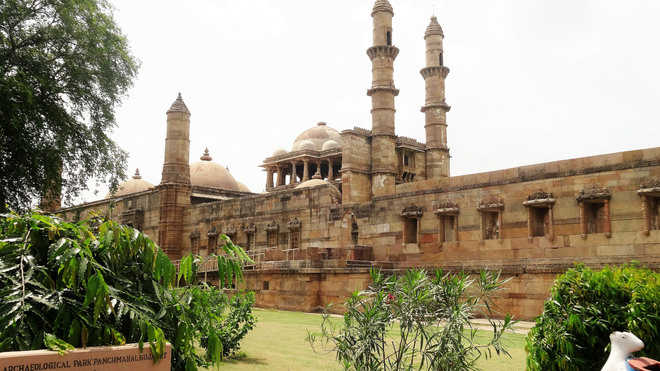
Jami Masjid in Champaner is one of the most imposing mosques
Kavita Kanan Chandra
Don’t let the rush of locals making a beeline to the Pavagadh hills flummox you. It is not the 15th and 16th century ruins of Gujarat sultanate capital of Gujarat Champaner or that of the forts of the Hindu kings on the Pavagadh hills that attract them. It is the call of the revered deity of Kalikamata atop the Pavagadh hills that sees hordes of pilgrims visiting the historical site. Such is the fate of Champaner that even after being declared Unesco World Heritage site in 2004, locals are not much enthused about roaming around in its ruins. Throughout history, this flourishing city founded by the king of Patan Vanraj Chavda in the eighth century has suffered ignominy, except for brief stints of fame.
An hour’s drive from the bustling Vadodara, Champaner and Pavagadh are worth a visit for anyone who has interest in art, architecture, archaeology, heritage and history. The two deservedly got their due by Unesco for being the only preserved Islamic pre-Mughal city also having Chalcolithic sites before that and ruins of temples dating back to 11th century. With mosques and Hindu and Jain temples, the site represents a confluence of cultures existing in tandem with each other. The large rectangular gateways of the broken fort walls at Halol and Godhra usher you into lush greenery of undulating landscape comprising the forested hill of Pavagadh and Champaner. The vast archaeological site spread over 6 sq km have remains of palaces, entrance gates and arches, fortifications, mosques, tombs and temples, residential complexes, agricultural structures and water installations such as stepwells and tanks, dating from the 8th to the 16th centuries AD. One of the excavated houses shows gardens, pavilions, stepped tanks and serpentine water channels.
Champaner stands out as a model of efficient town planning with well laid paved streets and an elaborate arrangement for water harvesting. There were numerous wells, stepwells, tanks and ponds fed by the Vishwamitri river and rivulets originating from the Pavagadh hills. The hills known to have the oldest rock formations in India had stone quarries to supply stones for heavy fortifications and buildings. Champaner stood out mostly for its unexcavated ruins that consists of mosques that show fine blend of Hindu-Islamic architecture.
One of the most imposing mosques is the Jami Masjid outside the royal enclosure. Raised on high plinth, it is accessed through three porches into an open courtyard that is wrapped by covered cloisters and an impressive prayer hall at one side. The entrance flanked by two carved minarets leads to multi-pillared hall that has a huge central dome raise two storeys high to let ventilation and natural light inside. The cool and lighted interior amazes one for this eco-friendly construction. Contrary to this public mosque is the royal mosque Saher-ki-masjid that also represent the blend comprising of pillars and beam in Hindu style and column and arches in Islamic style. Though the architecture has Islamic ethos, some elements like carvings of lotus insignia, kalash (pots) and vines and balcony below windows are predominantly temple architecture of Gujarat. The lila Gumbaj ki masjid even has a hanging kalash in prayer hall. Two other important mosques are Nagina Masjid and Kevada Masjid. As seen in these mosques, a style of architecture developed during the Gujarat Sultanate rule having exquisite stone detail carved screens.
Driving along the roads uphill towards Pavagadh, a few more tombs and mosques are in view as well as citadel walls. If you take the circuitous pilgrim’s path (route) trekking to the revered Shaktipeeth of Kalikamata temple, you got to see the ramparts and palace ruins along the way. Atop the forested hills are Digambar Jain temples from 13th century and Hindu temples like the oldest Lakulisa (10th-11th century) are still intact.
Adjacent to this is the oldest temple of Lakulisa and Jain temples (13th to 15th century). The temples have characteristic garbhagriha (sanctum sanctorum), mandapa and an outside porch reminiscent of Nagara style of architecture.
Even if you take the ropeway, the glimpse of ruins scattered across the verdant hills and plains are lovely to look at without straining your limbs. After paying obeisance to deities, you can bite into boiled corn on the cob and snack on Gujarati farsan to get energised to explore the hills reminiscent of living history.
Beauty eclipsed
The Pavagadh hills were ruled by Solanki kings and Khichi Chauhans, who had built the fortresses, said to be impregnable, but the Gujarat Sultanate ruler Mehmud Begada managed to lay siege of Pavagadh in 1498. He had already overtaken Champaner at Pavagadh foothills. Shifting his capital from Ahmedabad, Champaner rose to its zenith with massive architectural constructions and a flourishing trade and commerce. However, it quickly faded into oblivion when Mughals annexed Champaner and shifted the capital back to Ahmedabad. The British discovered it again as a village with its ruins overgrown with forests and made it as a facility for washing and preparing raw silk. But a cholera epidemic eclipsed it again till local heritage enthusiasts of Vadodara reclaimed its glory by persistent efforts to highlight its significance to international community.



























